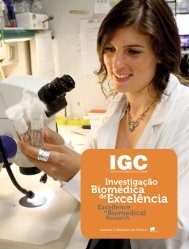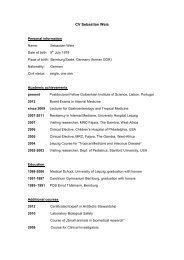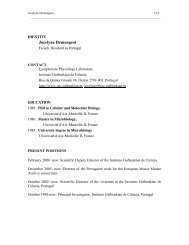organisation - the Instituto Gulbenkian de Ciência
organisation - the Instituto Gulbenkian de Ciência
organisation - the Instituto Gulbenkian de Ciência
- No tags were found...
Create successful ePaper yourself
Turn your PDF publications into a flip-book with our unique Google optimized e-Paper software.
NATIONAL AND INTERNATIONAL<br />
RESEARCH STRUCTURES<br />
LABORATÓRIO ASSOCIADO ITQB (LA-ITQB)<br />
Coordinator: Luís Paulo N. Rebelo (ITQB Director)<br />
Since January 2011, following a re-structure, <strong>the</strong> LA-ITQB brings toge<strong>the</strong>r <strong>the</strong><br />
<strong>Instituto</strong> <strong>de</strong> Tecnologia Química e Biológia (ITQB-UNL), <strong>the</strong> <strong>Instituto</strong> <strong>Gulbenkian</strong><br />
<strong>de</strong> Ciência (IGC), <strong>the</strong> <strong>Instituto</strong> <strong>de</strong> Biologia Experimental e Tecnológica (IBET) and<br />
<strong>the</strong> Centro <strong>de</strong> Estudos <strong>de</strong> Doenças Crónicas (CEDOC-UNL). The current LA-ITQB<br />
is a successor of a previous, smaller consortium, set up in 2001, between ITQB,<br />
IBET, and a few groups of IGC, as one of <strong>the</strong> first Associated Laboratories in<br />
Portugal. In its present form, it is a much wi<strong>de</strong>r partnership whose main aim is<br />
to carry out a collaborative research programme, un<strong>de</strong>rpinned by a strong communications<br />
network and sharing of infrastructures, namely libraries, scientific<br />
facilities, aca<strong>de</strong>mic services, and administrative support.<br />
It is currently one of <strong>the</strong> broa<strong>de</strong>st Associated Laboratories in terms of scientific<br />
expertise, spanning research areas from Chemistry to Medicine, along <strong>the</strong> following<br />
research <strong>the</strong>mes:<br />
1. Syn<strong>the</strong>sis, structure, and function of biologically important molecules;<br />
2. From genetics, cell and <strong>de</strong>velopmental biology to pathogenesis and novel<br />
<strong>the</strong>rapies;<br />
3. Computational and <strong>the</strong>oretical biology: from biochemistry to medicine;<br />
4. Host-microbe and host-cancer interactions;<br />
5. Plant genomics and stress responses;<br />
6. Evolution of ecosystems, biological risk, and food safety.<br />
In 2011, research at <strong>the</strong> LA-ITQB involved 350 PhD hol<strong>de</strong>rs (post-docs, group<br />
lea<strong>de</strong>rs), produced 425 Web of Science-referenced papers, over 10,000 WoS<br />
citations, 45 Highly Cited Papers (world top 1%), an average of one PhD <strong>the</strong>sis<br />
awar<strong>de</strong>d per week. Across <strong>the</strong> four research institutes, <strong>the</strong>re were over 380<br />
running projects, with several funding sources including over €5M from <strong>the</strong> European<br />
Commission. Also in 2011, a fur<strong>the</strong>r €3.5M euros income in I&D contracts<br />
with <strong>the</strong> private sector was secured.<br />
CHAMPALIMAUD FOUNDATION NEUROSCIENCE PROGRAMME AT THE IGC<br />
Head: Zachary Mainen<br />
PhD in Neurosciences, University of California, San Diego, 1995<br />
Principal Investigator - Systems Neuroscience Group<br />
The Champalimaud Neuroscience Programme (CNP) was created in 2007<br />
through a collaborative agreement between <strong>the</strong> Champalimaud Foundation and<br />
<strong>the</strong> Calouste <strong>Gulbenkian</strong> Foundation. It is a basic research team with <strong>the</strong> broad<br />
aim of un<strong>de</strong>rstanding brain function through integrative biological approaches.<br />
CNP laboratories apply advanced molecular, physiological and imaging techniques<br />
to elucidate <strong>the</strong> function of neural circuits and systems in animal mo<strong>de</strong>ls<br />
that inclu<strong>de</strong> Drosophila, mouse, rat and zebrafish.<br />
As of December 2011 <strong>the</strong> CNP comprises sixteen in<strong>de</strong>pen<strong>de</strong>nt research groups,<br />
including thirteen in-house principle investigators, one research fellow and two<br />
associated external principle investigators. This year, <strong>the</strong> CNP was joined by<br />
three new investigators (C. Machens, L. Petreanu, A. Renart), one research fellow<br />
(A. Kampff), and recruited ano<strong>the</strong>r investigator who will join <strong>the</strong> programme in 2012.<br />
In 2011, CNP investigators published 3 review articles and 10 refereed research<br />
articles, including a study on <strong>the</strong> role of <strong>the</strong> <strong>de</strong>ndritic branch in <strong>the</strong> potentiation<br />
pattern of single synapses, which was published in Neuron (I. Israely). Also, at<br />
<strong>the</strong> end of 2011, CNP investigators R. Costa and M. Carey received <strong>the</strong> International<br />
Early Career Scientist Award by Howard Hughes Medical Institute.<br />
The CNP also organises <strong>the</strong> International Neuroscience Doctoral Programme<br />
(INDP). In this programme stu<strong>de</strong>nts are provi<strong>de</strong>d with a broad educational background<br />
through both formal classes and hands-on experience in basic topics<br />
in contemporary neuroscience such as cellular and synaptic physiology, sensation<br />
and action and cognitive neuroscience. Quantitative approaches are<br />
emphasised and stu<strong>de</strong>nts also receive background courses in ma<strong>the</strong>matics and<br />
programming.<br />
IGC ANNUAL REPORT ‘11<br />
RESEARCH STRUCTURES<br />
105






